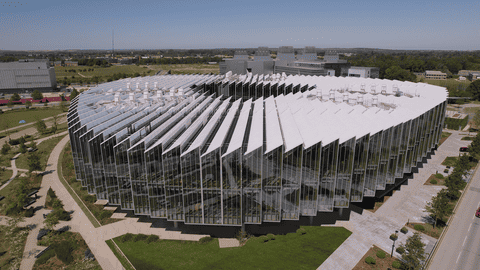
The UK life science sector has received another boost with the official unveiling of AstraZeneca’s (AZ) new £1bn research and development facility in Cambridge.
At a ceremony earlier this week HRH The Prince of Wales formally opened the facility, which will house 2,200 research scientists in 19,000m2 of laboratory space featuring the most advanced robotics, high-throughput screening and AI-driven technology.
CEO Pascal Soriot said AZ’s ambition was to “drive the next wave” of scientific innovation. “Our new Discovery Centre (DISC) in Cambridge raises the bar for sustainable R&D and global collaboration across our industry. It will allow us to break new boundaries in the understanding of disease biology, bring life-changing medicines to patients and power the next stage of our company’s growth,” he said.
The Discovery Centre will support AstraZeneca’s focus on specialised and precision medicines and foster the discovery and development of next-generation therapeutics, including nucleotide-based, gene-editing and cell therapies, said the company.
It will also play an important role in AZ’s R&D network, which already includes strategic research centres in Sweden and the US and development facilities in China and Japan. Much of the $7bn that AZ invests annually on R&D will be spent in the UK.
The Cambridge area has been a powerhouse of scientific innovation for more than a century with 50 Nobel Prize winners in chemistry and physiology or medicine. Groundbreaking discoveries include DNA revelations from Francis Crick and James Watson in 1953 and Professor Sir John Gurdon’s work on stem cells in 2012.
AZ hopes to capitalise on this by locating DISC in the Cambridge Biomedical Campus, stressing how the physical proximity to other important life sciences organisations including top hospitals, Cambridge University, research institutions and a range of biotechs will ‘promote a culture of open partnership and innovation’. The company has more than 200 collaborations across academia, biotech and industry in the region.
The disc-like structure is also ‘a feat of environmental engineering’ with its 174 boreholes that provide natural geothermal energy, four ‘hybrid cooling towers’ and a ground source heat pump that will save enough energy to power 2,500 homes.
Add to that low-energy ventilation, high levels of insulation and a ‘saw-tooth’ roof design that minimises energy use by flooding the interior with natural daylight. AZ hopes the building will contribute to its Ambition Zero Carbon programme that commits to zero carbon emissions by 2025 and for its entire value chain to be carbon negative by 2030.




